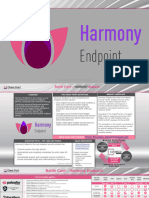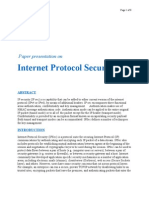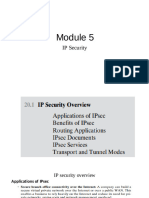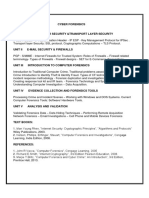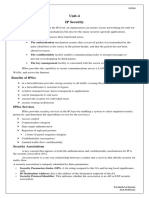0 ratings0% found this document useful (0 votes)
21 viewsIP Security
IP Security
Uploaded by
krii24u8IPSec provides security for IP networks through protocols and services. It offers encryption, message integrity, and protection from various security attacks. IPSec has two main modes - tunnel and transport. It benefits organizations by securing remote access, branch office connectivity, electronic commerce, and establishing extranets/intranets in a transparent manner without requiring changes to applications or user training. The IPSec architecture uses ESP and AH protocols to provide confidentiality, authentication, and integrity services.
Copyright:
© All Rights Reserved
Available Formats
Download as PDF, TXT or read online from Scribd
IP Security
IP Security
Uploaded by
krii24u80 ratings0% found this document useful (0 votes)
21 views18 pagesIPSec provides security for IP networks through protocols and services. It offers encryption, message integrity, and protection from various security attacks. IPSec has two main modes - tunnel and transport. It benefits organizations by securing remote access, branch office connectivity, electronic commerce, and establishing extranets/intranets in a transparent manner without requiring changes to applications or user training. The IPSec architecture uses ESP and AH protocols to provide confidentiality, authentication, and integrity services.
Copyright
© © All Rights Reserved
Available Formats
PDF, TXT or read online from Scribd
Share this document
Did you find this document useful?
Is this content inappropriate?
IPSec provides security for IP networks through protocols and services. It offers encryption, message integrity, and protection from various security attacks. IPSec has two main modes - tunnel and transport. It benefits organizations by securing remote access, branch office connectivity, electronic commerce, and establishing extranets/intranets in a transparent manner without requiring changes to applications or user training. The IPSec architecture uses ESP and AH protocols to provide confidentiality, authentication, and integrity services.
Copyright:
© All Rights Reserved
Available Formats
Download as PDF, TXT or read online from Scribd
Download as pdf or txt
0 ratings0% found this document useful (0 votes)
21 views18 pagesIP Security
IP Security
Uploaded by
krii24u8IPSec provides security for IP networks through protocols and services. It offers encryption, message integrity, and protection from various security attacks. IPSec has two main modes - tunnel and transport. It benefits organizations by securing remote access, branch office connectivity, electronic commerce, and establishing extranets/intranets in a transparent manner without requiring changes to applications or user training. The IPSec architecture uses ESP and AH protocols to provide confidentiality, authentication, and integrity services.
Copyright:
© All Rights Reserved
Available Formats
Download as PDF, TXT or read online from Scribd
Download as pdf or txt
You are on page 1of 18
IP Security
By: Dr. Juita T. Raut
SDSM College, Palghar
Overview
• A set of protocols and services which provides an entire security solution and also
multiple protection types for IP networks is known as IPSec.
• Protection mechanisms by IPSec:
• Client data encryption
• Message integrity
• Protection for types of security attacks
• Capability to negotiate the security algorithms
• Two security modes:- tunnel, transport
Application of IPSec
1) Secure remote access over the internet
2) Secure branch office connectivity over the internet
3) Improving Electronic commerce security
4) Establishing Extranet and Intranet connectivity with partners
Benefits of IPsec
When IPsec is implemented in a firewall or router, it provides strong security that can be applied to all traffic crossing the
perimeter. Traffic within a company or workgroup does not incur the overhead of security-related processing.
• IPsec in a firewall is resistant to bypass if all traffic from the outside must use IP and the firewall is the only means of
entrance from the Internet into the organization.
• IPsec is below the transport layer (TCP, UDP) and so is transparent to applications. There is no need to change
software on a user or server system when IPsec is implemented in the firewall or router. Even if IPsec is implemented in end
systems, upper-layer software, including applications, is not affected.
• IPsec can be transparent to end users. There is no need to train users on security mechanisms, issue keying material on
a per-user basis, or revoke keying material when users leave the organization.
• IPsec can provide security for individual users if needed. This is useful for offsite workers and for setting up a secure
virtual subnetwork within an organization for sensitive applications.
IPSec Services
• Access Control
• Message Integrity
• Entity Authentication
• Confidentiality
• Replay Attack Protection
Modes of Operations
• Tunnel mode: In this mode, entire IP packet is encrypted first. This will
becomes data component of a new and large size IP packet. This mode is
frequently used in IPsec VPN site to site topology.
• Transport mode: In this mode, IPsec header is inserted into original IP
packet. No new packet is being created here. This mode works well in
networks where increase in packet size is a concern. It is used in remote
access VPN topology type.
IPSec Architecture
IPSec (IP Security) architecture uses
two protocols to secure the traffic or
data flow. These protocols are ESP
(Encapsulation Security Payload) and
AH (Authentication Header). IPSec
Architecture includes protocols,
algorithms, DOI, and Key Management.
All these components are very
important in order to provide the three
main services:
•Confidentiality
•Authentication
•Integrity
• 1. Architecture: Architecture or IP Security Architecture covers the general
concepts, definitions, protocols, algorithms, and security requirements of IP
Security technology.
• 2. ESP Protocol: ESP(Encapsulation Security Payload) provides a
confidentiality service. Encapsulation Security Payload is implemented in
either two ways:
• ESP with optional Authentication.
• ESP with Authentication.
•Security Parameter Index(SPI): This parameter is
used by Security Association. It is used to give a unique
number to the connection built between the Client and
Server.
•Sequence Number: Unique Sequence numbers are
allotted to every packet so that on the receiver side
packets can be arranged properly.
•Payload Data: Payload data means the actual data or
the actual message. The Payload data is in an encrypted
format to achieve confidentiality.
•Padding: Extra bits of space are added to the original
message in order to ensure confidentiality. Padding
length is the size of the added bits of space in the
original message.
•Next Header: Next header means the next payload or
next actual data.
•Authentication Data This field is optional in ESP
protocol packet format.
• 3. Encryption algorithm: The
encryption algorithm is the document
that describes various encryption
algorithms used for Encapsulation
Security Payload.
• 4. AH Protocol: AH (Authentication
Header) Protocol provides both
Authentication and Integrity service.
Authentication Header is implemented in
one way only: Authentication along with
Integrity.
• Authentication Header covers the packet format and general issues related to the
use of AH for packet authentication and integrity.
• 5. Authentication Algorithm: The authentication Algorithm contains the set of
documents that describe the authentication algorithm used for AH and for the
authentication option of ESP.
• 6. DOI (Domain of Interpretation): DOI is the identifier that supports both AH
and ESP protocols. It contains values needed for documentation related to each
other.
• 7. Key Management: Key Management contains the document that describes how
the keys are exchanged between sender and receiver.
• Working of ESP:
1. Encapsulating Security Payload supports both main Transport layer protocols: IPv4 and IPv6 protocols.
2. It performs the functioning of encryption in headers of Internet Protocol or in general say, it resides and
performs functions in IP Header.
3. One important thing to note here is that the insertion of ESP is between Internet Protocol and other
protocols such as UDP/ TCP/ ICMP.
• Modes in ESP:
• Encapsulating Security Payload supports two modes, i.e. Transport mode, and tunnel mode.
• Tunnel mode:
1. Mandatory in Gateway, tunnel mode holds utmost importance.
2. Here, a new IP Header is created which is used as the outer IP Header followed by ESP.
• Transport mode:
1. Here, IP Header is not protected via encryption or authentication, making it vulnerable to threats
2. Less processing is seen in this mode, so the inclusion of ESP is preferred
• Advantages:
• Below listed are the advantages of Encapsulating Security Payload:
1. Encrypting data to provide security
2. Maintaining a secure gateway for data/ message transmission
3. Properly authenticating the origin of data
4. Providing needed data integrity
5. Maintaining data confidentiality
6. Helping with antireplay service using authentication header
• Disadvantages:
• Below listed are the disadvantages of Encapsulating Security Payload:
1. There is a restriction on the encryption method to be used
2. For global use and implementation, weaker encryptions are mandatory to use
ESP structure is composed of the following parts as shown below
:
• 1. Security Parameter :
• Security parameters are assigned a size of 32 bits for use
• Security Parameter is mandatory to security parameter in ESP for security links and associations
• 2. Sequence Number:
• The sequence number is 32 bits in size and works as an incremental counter.
• The first packet has a sequence number 1 assigned to it whenever sent through SA
• 3. Payload Data:
• Payload data don’t have fixed size and are variable in size to use
• It refers to the data/ content that is provided security by the method of encryption
• 4. Padding:
• Padding has an assigned size of 0-255 bytes assigned to it.
• Padding is done to ensure that the payload data which needs to be sent securely fits into the
cipher block correctly, so for this padding payloads come to the rescue.
• 5. Pad Length:
• Pad Length is assigned the size of 8 bits to use
• It is a measure of pad bytes that are preceding
• 6. Next Header:
• The next header is associated with a size of 8 bits to use
• It is responsible for determining the data type of payload by studying the first header
of the payload
• 7. Authentication Data:
• The size associated with authentication data is variable and never fixed for use-case
• Authentication data is an optional field that is applicable only when SA is selected. It
serves the purpose of providing integrity
You might also like
- Braindump2go SY0-601 PDF and SY0-601 VCEDocument75 pagesBraindump2go SY0-601 PDF and SY0-601 VCE曾崇哲100% (1)
- Battle Card - HARMONY Endpoint - May20Document5 pagesBattle Card - HARMONY Endpoint - May20Gfact MailNo ratings yet
- Anonymous RAT Setup For Dummies PDFDocument1 pageAnonymous RAT Setup For Dummies PDFIvan OrtizNo ratings yet
- Qlik NPrinting InstallationDocument12 pagesQlik NPrinting Installationmalikul12No ratings yet
- Module 5Document33 pagesModule 5John VeigasNo ratings yet
- Unit-V - Network Security, Cyber Laws & StandardsDocument71 pagesUnit-V - Network Security, Cyber Laws & Standardssurajborgave161No ratings yet
- C&NS Unit-6 R16Document29 pagesC&NS Unit-6 R16Geethanjali KotaruNo ratings yet
- Presented By: Anurag Roll No:-1703233 Topic: Network SecurityDocument28 pagesPresented By: Anurag Roll No:-1703233 Topic: Network SecurityAnurag GuptaNo ratings yet
- Internet Protocol Security: Paper Presentation OnDocument8 pagesInternet Protocol Security: Paper Presentation OnSugumar MarimuthuNo ratings yet
- Unit 5Document47 pagesUnit 5Amaanulla MokashiNo ratings yet
- BRC-IP Security (IPSec)Document32 pagesBRC-IP Security (IPSec)anshul1508 namdeoNo ratings yet
- Ip Security Overview: Applications of IpsecDocument14 pagesIp Security Overview: Applications of IpsecDivyaThalankiVenkataNo ratings yet
- CSCI 467 - IP and Web Security: Chapter 16, 17 From Cryptography and Network Security, 4 Edition, William StallingsDocument48 pagesCSCI 467 - IP and Web Security: Chapter 16, 17 From Cryptography and Network Security, 4 Edition, William StallingssanjaynolkhaNo ratings yet
- Introduction To IpsecDocument21 pagesIntroduction To IpsecSarthak PaliwalNo ratings yet
- Unit 4 (Part 1)Document64 pagesUnit 4 (Part 1)Akshay UtaneNo ratings yet
- 4.U5 M1 T4 IP SecurityDocument41 pages4.U5 M1 T4 IP SecurityGuru PrasathNo ratings yet
- Ip Security: Submitted To: Prof, Abdul HananDocument17 pagesIp Security: Submitted To: Prof, Abdul HananArslan Kamran JuttNo ratings yet
- Unit 4Document32 pagesUnit 4teja mNo ratings yet
- CNS Unit 4 Ip SecDocument15 pagesCNS Unit 4 Ip SecswedhaaaeceNo ratings yet
- NS 2nd QB AnswersDocument10 pagesNS 2nd QB Answerskesebas6exNo ratings yet
- Cryptography Module 5Document84 pagesCryptography Module 5Myth OPNo ratings yet
- Networksecurity3rdmoduledr 230408050150 852c8d47Document37 pagesNetworksecurity3rdmoduledr 230408050150 852c8d47Dr. Shiva shankarNo ratings yet
- Group 2 Info409 PresentationDocument55 pagesGroup 2 Info409 PresentationTanaka MatendNo ratings yet
- CNS Unit-4Document51 pagesCNS Unit-4RmkumarsNo ratings yet
- What Are The Three Functional Areas That Ipsec Encompasses?Document7 pagesWhat Are The Three Functional Areas That Ipsec Encompasses?Mukesh BollineniNo ratings yet
- Module 5 - IP Security, Transport and Tunnel Modes - Lecture NotesDocument22 pagesModule 5 - IP Security, Transport and Tunnel Modes - Lecture Notesxgy5807No ratings yet
- The Idea To Encrypt and Seal The Transport and Application Layer Data During Transmission Also Offer Integrity Protection Is Called IP SecurityDocument18 pagesThe Idea To Encrypt and Seal The Transport and Application Layer Data During Transmission Also Offer Integrity Protection Is Called IP Securityrh_rathodNo ratings yet
- Wa0014.Document6 pagesWa0014.anilkumarkatru07No ratings yet
- Presented By: Anurag Roll No:-1703233 Topic: Network SecurityDocument28 pagesPresented By: Anurag Roll No:-1703233 Topic: Network SecurityAnurag GuptaNo ratings yet
- IP Security: Dr. H.R. ChennammaDocument22 pagesIP Security: Dr. H.R. ChennammaRajendra PrasadNo ratings yet
- Isec311 LCN 07Document38 pagesIsec311 LCN 07Ayan leghariNo ratings yet
- Premium VPNDocument44 pagesPremium VPNMedo KassabNo ratings yet
- Module 5Document43 pagesModule 5rashmiNo ratings yet
- 18CS744 Module5 NotesDocument23 pages18CS744 Module5 Notesakashroshan17No ratings yet
- CF Full Notes PDFDocument240 pagesCF Full Notes PDFKarthi KeyanNo ratings yet
- 16MDS82 DPS Unit 4.2Document23 pages16MDS82 DPS Unit 4.2data1.waangooNo ratings yet
- IPSecDocument25 pagesIPSecAMMAN ASAD (RA2011030030031)No ratings yet
- 6 IP SecurityDocument30 pages6 IP SecurityWHATSAPP STATUSLYNo ratings yet
- CS - 6004 Cyber Forensics 1 PDFDocument80 pagesCS - 6004 Cyber Forensics 1 PDFCharulatha50% (2)
- Ipsec and VPN: Ali Bodden Joseph Gonya Miguel MendezDocument30 pagesIpsec and VPN: Ali Bodden Joseph Gonya Miguel MendezshahrianNo ratings yet
- COmputer SecurityDocument11 pagesCOmputer SecurityJerry ONo ratings yet
- IP Sec Unit 5 CNSDocument21 pagesIP Sec Unit 5 CNSJaguar cocNo ratings yet
- Network Security and EcommerceDocument49 pagesNetwork Security and EcommerceElisha NdhlovuNo ratings yet
- Unit-4 Ip Security: Benefits of IpsecDocument12 pagesUnit-4 Ip Security: Benefits of IpsecLokesh Sai Kumar DasariNo ratings yet
- Unit-5 - Network SecurityDocument97 pagesUnit-5 - Network Securityyototi8935No ratings yet
- IPSecDocument25 pagesIPSecDinesh ParasharNo ratings yet
- IpsecDocument21 pagesIpsecShruti PawarNo ratings yet
- Defining Network Infrastructure and Security: Lesson 8Document28 pagesDefining Network Infrastructure and Security: Lesson 8Pradeep ManralNo ratings yet
- IpsecuDocument19 pagesIpsecuVandana PavithranNo ratings yet
- ENARSI - Chapter - 20 - Securing DMVPN TunnelsDocument31 pagesENARSI - Chapter - 20 - Securing DMVPN TunnelsAnna DangNo ratings yet
- Chapter 8: Implementing Virtual Private NetworksDocument168 pagesChapter 8: Implementing Virtual Private NetworksRyanb378No ratings yet
- IP SecurityDocument3 pagesIP SecurityDigital NikhilNo ratings yet
- Virtual Private NetworkDocument41 pagesVirtual Private NetworkNihar Sawant100% (1)
- Jsaer2015 02 02 94 98Document5 pagesJsaer2015 02 02 94 98jsaereditorNo ratings yet
- Cryptography and Network Security: IpsecDocument51 pagesCryptography and Network Security: IpsecRajnish BediNo ratings yet
- IP Security OverviewDocument16 pagesIP Security OverviewlukastoniNo ratings yet
- Mobile Ip: Security & Application: December 1, 1999Document8 pagesMobile Ip: Security & Application: December 1, 1999Vijay SharmaNo ratings yet
- Ipsec: Security Across The Protocol Stack: Brad Stephenson Csci NetprogDocument27 pagesIpsec: Security Across The Protocol Stack: Brad Stephenson Csci NetprogAnkita BaidNo ratings yet
- Chapter 08Document27 pagesChapter 08willy muhammad fauziNo ratings yet
- 54-IP-Sec (Authentication Header) - 23-04-2024Document17 pages54-IP-Sec (Authentication Header) - 23-04-2024Shweta SNo ratings yet
- Network Security Essentials: Fourth Edition by William StallingsDocument27 pagesNetwork Security Essentials: Fourth Edition by William StallingsXozanNo ratings yet
- Securing Communication of Legacy Applications with IPSec: Step-by-Step Guide to Protecting “Data in Transit” without Changes in Your Existing SoftwareFrom EverandSecuring Communication of Legacy Applications with IPSec: Step-by-Step Guide to Protecting “Data in Transit” without Changes in Your Existing SoftwareNo ratings yet
- Cyber Law QBDocument82 pagesCyber Law QBkrii24u8No ratings yet
- Plant Monitoring System DocumentationDocument41 pagesPlant Monitoring System Documentationkrii24u8No ratings yet
- Fraud Case Study (Cyber Forensics)Document7 pagesFraud Case Study (Cyber Forensics)krii24u8No ratings yet
- Presentation On Self DefenceDocument13 pagesPresentation On Self Defencekrii24u8No ratings yet
- Classical CryptographyDocument36 pagesClassical CryptographyJatin GoyalNo ratings yet
- Block Chain Technology: Unit - 1Document42 pagesBlock Chain Technology: Unit - 1Keshav RaoNo ratings yet
- h12 711 EnuDocument6 pagesh12 711 EnuRachid AbdelNo ratings yet
- Data Breaches in India A Growing ConcernDocument8 pagesData Breaches in India A Growing ConcernlotawoNo ratings yet
- DBMS PresentationDocument17 pagesDBMS Presentationsantoshmahato2481832No ratings yet
- Impact of Quantum Computing On CryptographyDocument6 pagesImpact of Quantum Computing On CryptographySanthosh DheerajNo ratings yet
- CSC 411 Intenet and Network SecurityDocument6 pagesCSC 411 Intenet and Network SecurityRichyNo ratings yet
- OTP Authentication Finacle Integration Approach PDFDocument2 pagesOTP Authentication Finacle Integration Approach PDFpuneet mishraNo ratings yet
- AIX Operating System Hardening ProceduresDocument10 pagesAIX Operating System Hardening ProceduresRashid NihalNo ratings yet
- Cybersecurity Awareness TrainingDocument13 pagesCybersecurity Awareness TrainingFravin100% (1)
- CNS Module 2Document23 pagesCNS Module 2shahemaNo ratings yet
- Assignment 1Document5 pagesAssignment 1SamaherNo ratings yet
- Wp-Oracle-jdbc Thin SSL 2007Document22 pagesWp-Oracle-jdbc Thin SSL 2007Rolando CanalesNo ratings yet
- 6003Document73 pages6003Teguh FALCONo ratings yet
- Lecture 3Document28 pagesLecture 3Nereyda WilliamsNo ratings yet
- Federal Laws For Prosecuting Computer Attacks: Ethics in Information Technology, Fourth EditionDocument25 pagesFederal Laws For Prosecuting Computer Attacks: Ethics in Information Technology, Fourth EditionMichael PerezNo ratings yet
- Connection Setup - SAP BPC NW 10.1Document8 pagesConnection Setup - SAP BPC NW 10.1Waqar Alam KhanNo ratings yet
- Forensic Decryption of FATDocument14 pagesForensic Decryption of FATpetter.plopes3157No ratings yet
- A01 Assignment 1Document10 pagesA01 Assignment 1st57143No ratings yet
- NSS Labs AEP Comparative Report SecurityDocument7 pagesNSS Labs AEP Comparative Report SecurityhugobiarNo ratings yet
- PDF cs8792 Cryptography and Network Security - CompressDocument10 pagesPDF cs8792 Cryptography and Network Security - Compress5047 Sucharitha.MNo ratings yet
- Network Security PDFDocument4 pagesNetwork Security PDFSUREKHA SNo ratings yet
- KSA T318 MTA FALL 2022 2023 AnswerDocument6 pagesKSA T318 MTA FALL 2022 2023 AnswerMohamed El ShazlyNo ratings yet
- 335041-TIS TD CCCv2Document27 pages335041-TIS TD CCCv2Vijju Vijayendra PSNo ratings yet
- Security Vendor QuestionnaireDocument2 pagesSecurity Vendor Questionnairetest fypNo ratings yet
- Ransom Cloud enDocument33 pagesRansom Cloud enJoelcio Ribeiro GomesNo ratings yet

